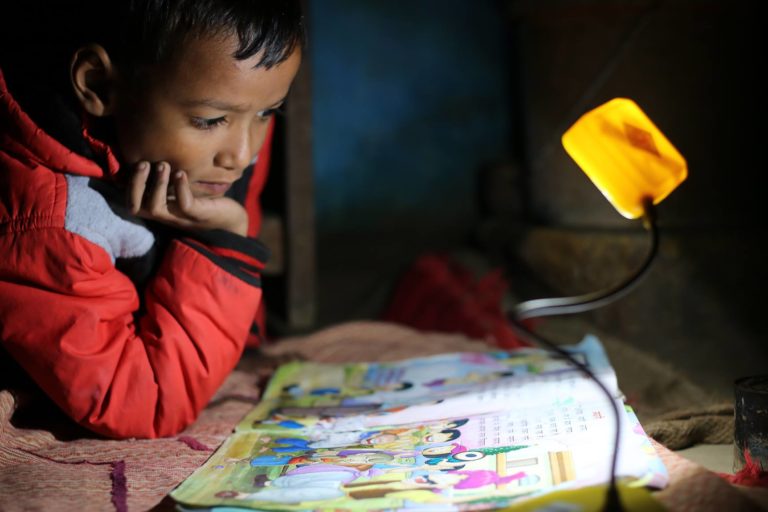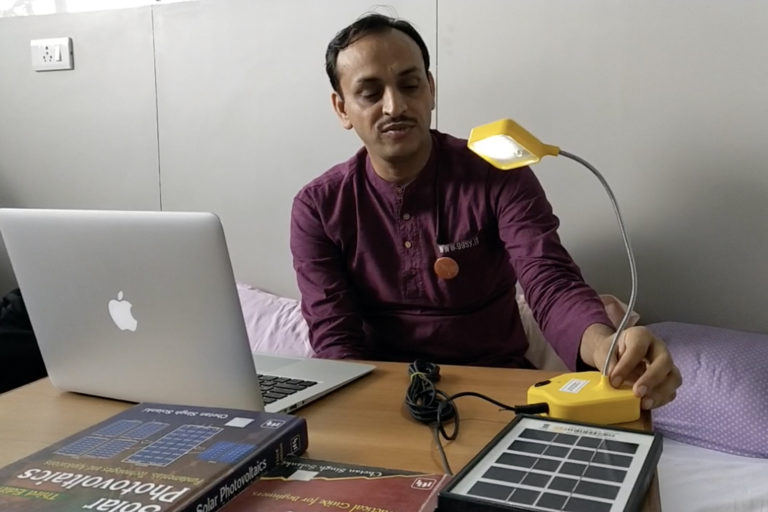
Kanchan Srivastava is an Independent Journalist who writes on Environment, Policy and Politics.
This October, while India hosts grand celebrations to mark the 150th birth anniversary of Mahatma Gandhi, over a million students from over 100 countries across five continents will pay tribute to the Father of our Nation – in a way he would have probably truly appreciated. They are expected to assemble their solar study lamps.
Chetan Singh Solanki, an associate professor at the Department of Energy Science and Engineering, Indian Institute of Technology Bombay, is spearheading a unique campaign that involves children from across the world making solar-charged study lamps in their schools and taking a pledge of “non-violence to environment” as a tribute to Gandhi and his teachings.
The components of the lamp, which has an illuminance of 150 lux for four hours, cost around Rs. 500 and will be procured by the schools from open source (physical or online shops).
“The message these young minds will take home through this activity can make a bigger impact than all save-the-environment campaign,” says Solanki.
Over 6 million children in over a dozen states including Rajasthan, Madhya Pradesh, Assam, Meghalaya have been provided with this lamp on subsidised rate, thanks to Solanki’s initiative “Right to Light” started in 2013 with the Centrally funded project-Million SoUL (One million Solar Urja Lamps).
The project, worth Rs. 5.5 billion (550 crores), aims to empower the school going students with localised assembly, sale and usage of one million solar lamps in rural India. It reinforces Sustainable Development Goals 7 (ensure access to affordable and clean energy) and 13 (take urgent action to combat climate change) by creating a local solar ecosystem to power communities with affordable and alternate energy.
“The SOuL project aims to meet the power needs of children in rural India, improve learning outcomes and curb school dropout rates. The project also hopes to generate employment for village youth and women involved in assembly and repair of these lamps,” says Solanki.
He aims to reach 300 million children, aged below 14, across the world with this lamp over the next 10 years.
To make this happen, he planned and proceeded on the Gandhi Global Solar Yatra in three phases early this year covering 30 countries across five continents – Asia, South America, North America, Africa and Europe. This includes Brazil, United States of America, Cambodia, Ethiopia and Middle East countries and all major cities of India as well.
Solanki says, “The school children of these countries who I met personally or digitally during this journey will be the ambassadors of solar energy and Energy Swaraj (self-reliance of communities and institutions on energy).”
We need to adopt the model of Gandhi Ji’s Gram Swaraj and apply it to Energy. Where local communities will be self-sufficient in generating and fulfilling their own #energy needs. That is what I call “#EnergySwaraj”#ClimateStrike #ClimateChange #SSA #SDGs pic.twitter.com/UswE7yhNfK
— Chetan S Solanki (@DrChetanSolanki) September 25, 2019
Why India needs solar energy?
Although the Union government claims that all rural and urban households across the country had been electrified by March 31, 2019, under Pradhan Mantri Sahaj Bijli Har Ghar Yojana (Saubhagya), media reports say otherwise. Over 140,000 households in Rajasthan and 40,000-odd households in Chhattisgarh were yet to be electrified as on July 1, 2019.
The government’s next target – 24/7 power supply – appears to be a distant dream, say industry experts. As per the government figures, India’s energy requirement in 2018-19, stood at 1,274 billion units while its availability was 1,267 billion units.
“Many villages, especially the hamlets in remote hilly and forest regions, still lack power connection, the electrified ones also get a few hours supply only. In such a scenario, solar lamp comes as a great support for school going children,” says Solanki who now hopes to reach 300 million children of the world aged below 14 with this lamp in the next 10 years.
Lauding Solanki’s efforts, Ravi Sinha, professor and head of the Civil Engineering Department, IIT Bombay, says, “This project aims to meet the electricity needs of rural kids with cleaner options, improve learning outcomes, curb dropout and generate employment for village youths and women for assembly and repair of these lamps.”
Over 400 children enrolled in the Government Primary School, Neemhar, Bodhgaya in Bihar are among those beneficiaries. School teacher Vijay Kumar tells Mongabay-India, “While most households in the village have power connection, prolonged power cut affected the residents, especially students. Since they have got Rs. 100 solar lamp last year, they are able to study in the evening.”
While women self-help group of the village assembled the lamps as per the IIT-B guidance, a few men were trained in repair.
“Over 1.8 million children from six districts of Bihar have been covered under the scheme so far using the same strategy,” says Abhilasha, project manager of the Soul.
The SoUL team identifies the needy villages with the help of National Rural Livelihood Mission and then approach the state-run schools. Villages dominated by scheduled castes and scheduled tribes are given priority.
Solanki says, “Apart from the rising gap between supply and consumption in India, depletion of conventional energy sources has changed the entire focus on renewable energy. India’s recent status of lowest-cost producer of solar power further reflects an ongoing shift towards renewable power.”
India has invested huge money in the solar energy field. In 2010, the total installed solar capacity was 10 MW which touched 30 GW by March 2019, accounting for five-fold rise in three years.
The fresh target is to produce 100 GW solar energy by 2022 which will contribute 40% to the renewable energy folder.
A senior official associated with Ministry of News and Renewable Energy told Mongabay-India, “The efforts are on to reduce the burden on conventional energy through a combination of renewable energy-based projects such as solar, wind, biomass, small hydro, waste to energy. Hence, solar parks, solar campuses, solar agriculture pumps and waste to energy projects are being promoted.”
The Kochi International Airport already has fully solar-powered operations, bagging the tag of world’s first power neutral airport in august 2015. Prime Minister Narendra Modi during his visit to the airport had said it should be an inspiring model for energy guzzlers.
Confident by the growth rate in clean energy sector, the government in its submission to the United Nations Frame Work Convention on Climate Change on Intended Nationally Determined Contribution (INDC) has stated that India will achieve 40% electricity from non-fossil resources by 2030.
Abhishek Jain, who runs “Bijli Bachao” movement, said, “Renewable energy also has significant environment benefits making it the single biggest driver to help us meet our carbon emission reduction targets in our fight against climate change. With India being a growing economy, power consumption is only going to rise, so adoption of alternate forms of energy is the ideal way forward to manage balance between economic growth and sustainable environment.”
The man behind the mission
Like his idol Mahatma Gandhi, Solanki believes in practising what he preaches.
His laboratory is in stark contrast to the other swanky laboratories on the IIT campus. On the ground is a large mattress, some pillows, and a chowki (wooden bench) with sunlight streaming in from large open windows. Tube-lights and fans are all strictly turned off unless needed – whether in his lab, office or home. “I have stopped using air conditioner, refrigerator, oven and geyser at my apartment (on campus). Only low energy bulbs, DC fans and TV are used.” His students too often cook staples like rice and dal on solar hotplates at the lab even as they work on developing a solar rice cooker.
Solanki, who hails from Khargone district in Madhya Pradesh, has just completed his six-month-long Gandhi Global Solar Yatra to sensitise school children in over 30 countries across five continents about the need to cut down carbon footprint and switch to solar energy. “Only government efforts are not enough to stop climate change. People, especially children, can bring real change. We will have to sacrifice many comforts to save our planet,” said the professor, who also leads two government-sponsored projects – the National Center for Photovoltaic Research and Education (NCPRE) and the SoULS initiative, which reinforces Sustainable Development Goals 7 and 13 by creating a local solar ecosystem to power rural lives across the country.

His next goal is to roll out a ‘Surrender Electricity Connection’ campaign, on the lines of the Centre’s Surrender Gas Subsidy initiative, for conservation of fossil fuel and curbing of carbon emission. “I hope at least 1 lakh families will relinquish their power connection and switch to solar energy within a year,” says Solanki, who is in the process of wrapping up his book, My Experiments with Solar Truths.
On 15th August, Independence Day, this year, Solanki launched a non-governmental organization (NGO), Energy Swaraj Foundation, Mahatma Gandhi’s Sabarmati Ashram in Gujarat. “The NGO seeks to usher in ‘Energy Swaraj’ in villages by making them energy self-sufficient by generating clean energy for their needs,” said Solanki, who also teaches Yoga and meditation occasionally.
While research grants have shrunk over the years, Solanki faces a different challenge. “I got the Central grants of Rs 550 crore. My institution expressed inability to handle such huge amount as entire IITB budget is Rs 350 crore. Hence, other organisations have been roped in.”
A serial innovator
An intrepid man of science, Solanki has led several other projects that have resulted in cutting-edge innovations.
Under his leadership, IIT-Bombay students developed a direct current-based solar photovoltaic cookstove, which bagged top honours at the National Solar Chulha Challenge organized by Oil and Natural Gas Corporation in 2018. The initiative aimed at developing a cost-effective and efficient solar-powered stove system for clean household cooking. The winning cookstove is powered by 1 kW of solar power and a 7 kWh capacity battery to operate at night. It costs around Rs 20,000 and can cook three meals daily for a five-member family. The cookstove is currently being tested in Bancha village of Betul district, Madhya Pradesh.
It has two 1000 W induction cooktops and a 500 W cooker. It provides the convenience of cooking at night as well, powered by the battery, thus coping with the challenge that the solar cookers have faced for many years.
Another IIT Bombay team, led by Solanki, has developed a solar tea cart, which costs around Rs 65,000 as a means to address employment needs of young people in the country.
This article is republished from Mongabay under a Creative Commons license. Read the original article.













